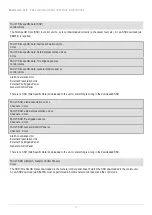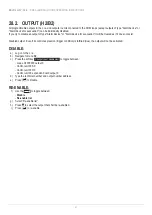
EBL512 G3 V. 3.0.X
- FIRE ALARM SOLUTIONS OPERATING INSTRUCTIONS
77
23. COMMISSIONING
Before you connect the power supply to a control unit, all other cable connections shall be made. Check once more that they are
correct.
A tip! Measure the resistance of each loop wire (L & C respectively) before turning on the power. Check that the L-wire (SA) that
goes out on terminal J5:1 comes back at terminal J5:3 and so on. If the loop has short circuit isolators, only the C-wire (SB) can be
measured.
Also measure the resistance between the loop wires and 24V, 0V and Earth (J2:1, 2 and 3). The resistance should be very high
(mega ohm).
23.1. SINGLE CONTROL UNIT
a) Take away the rectifier fuse (F1) and the battery fuse (F2) on the main board.
b) Connect the batteries to the main board, terminal block "J2".
In a single / standalone control unit there shall be no network board plugged on the main board.
There shall be an in-line-fuse (F) on the cable between the batteries, see Technical description for the c.i.e.
It shall be connected to a household removable fuse for the fire alarm c.i.e. only, via a two-way circuit
breaker. National regulations always must be followed. The mains cable shall be securely clamped and
the wires shall be as short as possible. The mains safety earth (ground) shall, however, be longer than the
other wires, to ensure that it is the last to be disconnected if the mains cable clamp should fail. The lid pro-
tecting the rectifier screw terminals shall after the installation be correctly applied.
RISK OF EXPLOSION IF BATTERY IS REPLACED BY INCORRECT TYPE. DISPOSE USED BATTERIES
ACCORDING TO THE INSTRUCTIONS.
c) Connect the rectifier to the mains (230 V AC). A cable tie shall be mounted to keep the mains wires well separated from the
24 V DC wires.
d) First put back the battery fuse (F2) and then the rectifier fuse (F1) on the main board.
e) LED "Operation" indicate that the 24 V DC power supply is okay (rectifier and/or battery).
f) The c.i.e. will do a restart, see chapter
.
g) The site specific data (SSD) – created in EBLWin – can now be downloaded, see Planning Instructions for the system.
h) See also section




































